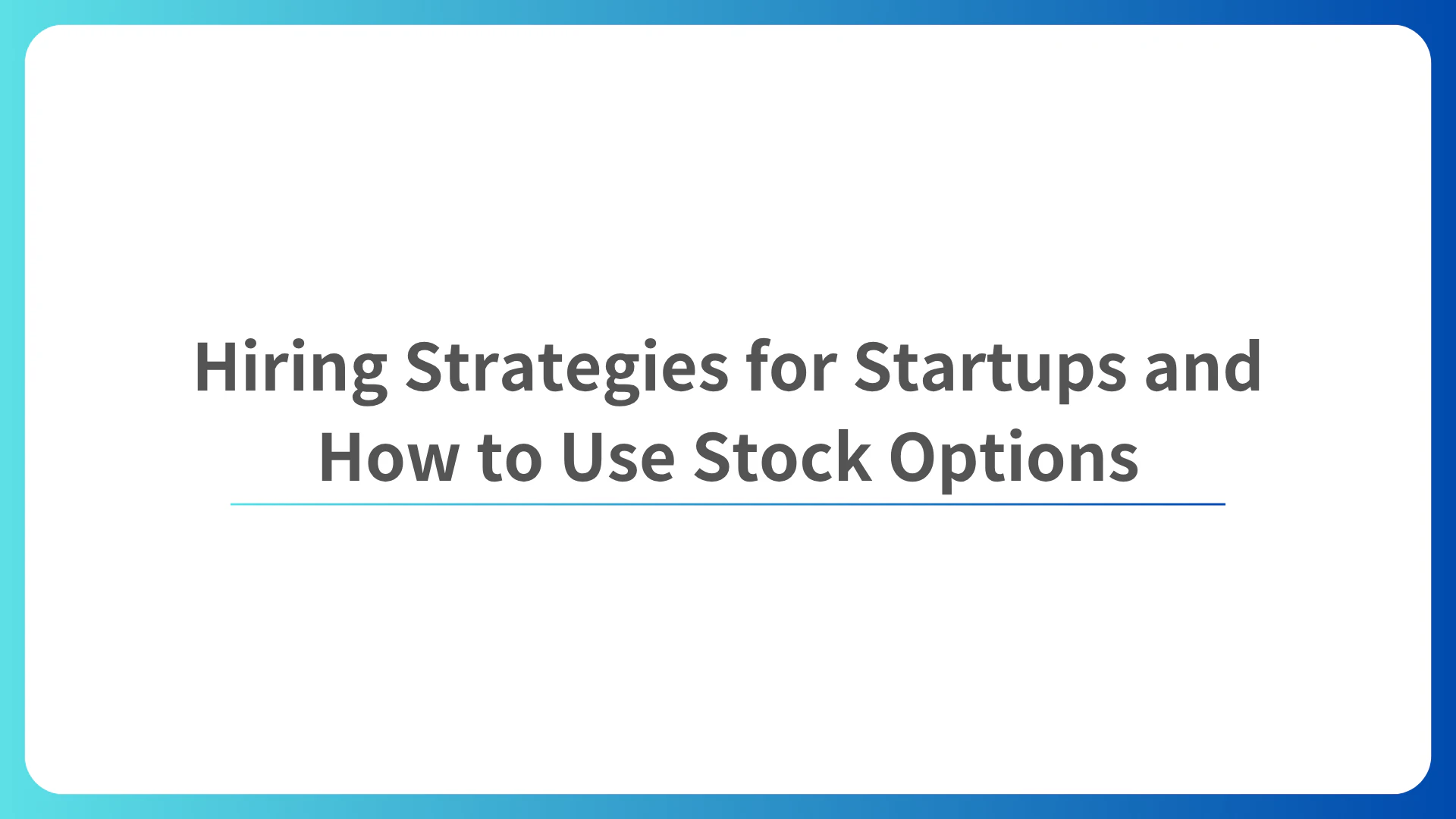- #recruitment strategy
- #startup
- #stock-option
Hiring Strategies for Startups and How to Use Stock Options
 Ryutaro Imai
Ryutaro Imai
This article explains hiring strategies for startups that are struggling to attract top talent and how to leverage stock options. Note: This article is based on Japanese law.
Hiring Strategies for Startups and How to Use Stock Options
Hello, this is Imai, CEO of BizDB Inc.
I imagine many companies are having a tough time with hiring and organizational design. For startups in particular, you often have to begin hiring with no money, no people, and no connections, which can be extremely challenging (our company is one of them).
There are many recruiting platforms like BizReach and Wantedly, but all of them are costly, and large enterprises are hiring with high salaries. Startups without money must communicate other forms of appeal.
You carefully convey your mission, your unique product, and who the founding team is, send out tons of scouting messages, and finally land an interview. And even when you do make a hire, they sometimes quit soon after; retention is hard. Revenue doesn’t grow quickly enough to raise salaries. It’s really hard. I feel that pain—deeply.
For startups in that situation, I’d like to share my own perspective on hiring strategy and how to use stock options (SO).
The Limits of Referral Hiring
Referral hiring is a very effective tool for startups, but it has several limitations and downsides.
Founding-Member-Max Theory
Especially in the early days, it’s common that referral hiring won’t bring in people more capable than the founding members. From a candidate’s perspective, few would be willing to stake their life on someone they consider less capable and take on high risk, and they won’t jump into a company with little or no revenue. Unless the business is already gaining traction and revenue is growing, you should assume that people more capable than you are unlikely to join.
It Tends to Create Blind Spots
Referral hiring tends to gather people with similar backgrounds. If there are multiple founders with completely different histories, this may not be an issue. But when you start a company with former colleagues or college friends, work histories and backgrounds tend to resemble each other, and naturally your strengths and weaknesses align as well. As a result, when you pivot or try new initiatives, your range of possible moves narrows—this is a commonly observed pattern.
There’s a Hard Cap on Headcount You Can Hire
Needless to say, personal networks are finite, so compared to recruiting platforms, there’s a built-in limit.
Using Recruiting Platforms Means Bracing to Compete with Big Companies That Have Money, Environment, and Everything Else
When referral hiring hits its limit, many companies turn to recruiting platforms. But we’re in an all-out war for talent now—it’s incredibly tough.
A while back when direct recruiting started to trend, big companies hadn’t yet entered platforms like BizReach and Wantedly, so startups could still hire there. Recently, though, large domestic firms and major multinationals have piled into these platforms, intensifying competition.
Therefore, to beat them, the only path left is to emphasize the kinds of appeal that only a startup can offer—advantages big companies can’t provide.
To Beat Big Companies With Higher Salaries, Stock Options Are the Only Way
I often get this question: “We want to hire great people, but our revenue isn’t there yet so we can’t pay high salaries. What should we do?” For startups, there’s one thing you can do: grant stock options.
What Are Stock Options?
Stock options (SO) are a system that gives employees and directors the right to purchase the company’s shares in the future at a predetermined price (the exercise price). When startups use SO as a salary substitute or success-based reward in Japan, tax-qualified stock options are often chosen; if certain requirements are met, taxation at exercise can be deferred so that only capital gains tax applies at sale.
Because an SO is a right, not cash compensation, there’s no actual cash outflow until exercise, allowing the company to conserve capital. The lower the share price at grant, the lower the exercise price you can set, and future share price appreciation becomes the employee’s upside.
Tax treatment differs at grant, exercise, and sale, so it’s standard to consult experts during plan design and lock down the “eligible recipients, number of options, exercise price, and vesting conditions.”
How Much Can You Reduce Salary by Granting SO?
Model case: Hiring an engineer in Seed–Series A
- Switching from a large company: annual salary ¥10,000,000
- Startup offer: annual salary ¥7,000,000 (−30%) + SO 0.5% (as a percentage of total shares outstanding)
Assume an IPO in 7 years with a market cap of ¥10 billion, 10 million shares outstanding, exercise price ¥100, and an IPO price of ¥1,000. The capital gain on 0.5% = 50,000 shares would be roughly (¥1,000 − ¥100) × 50,000 ≈ ¥450,000,000. This far exceeds the ¥3,000,000 annual discount × 7 years = ¥21,000,000, making it easier for candidates to accept a salary cut in exchange for potential upside.
In practice, it’s common to offset 10–35% of annual cash salary with SO value. The earlier the role and funding stage, the higher the typical discount.
The Fastest Way to Raise Employee Engagement Is Stock Options
- Economic incentives. Because SO directly links “increasing company value” with “personal gain,” people develop the habit of thinking autonomously about how their day-to-day work affects share price (enterprise value).
- Psychological ownership. Having one’s name on the shareholder register (or being on track to exercise) shifts the mindset from “employee” to “co-builder,” strengthening commitment to the culture.
- Greater information transparency. Because SO holders need visibility into management metrics and equity policy, dialogue with leadership increases; many cases report higher engagement scores as a result.
With the Right SO Design, You Can Lock In Employees and Reduce Attrition
Startups adopt stock options (SO) primarily to (1) attract top talent and (2) raise engagement among existing members. However, if all options could be freely exercised and sold from day one, you’d face the risk of people “grabbing the equity and leaving” right after joining. That’s why vesting is essential.
What Is Vesting?
Vesting is a mechanism that makes granted stock options become exercisable gradually based on “passage of time” and/or “achievement of performance goals.” Because unvested rights can be forfeited upon resignation or termination, you create a strong incentive: the longer someone stays, the more they earn; if they leave, they lose.
- Most common pattern: 100% over 4 years
- 1-year cliff (0% for the first 12 months)
- From month 13, 25% vests each year
- 100% vested at the end of year 4
Lock-up effect via vesting
Because the risk of losing unvested options is clear, the cost of quitting rises → attrition falls, making it easier to recoup hiring costs.
For startups struggling with “we can’t match salaries” and “we can’t hire fast enough,” it’s exactly this stock-option design—one that retains top talent while conserving cash—that should be placed at the core of strategy as early as possible.
Author

Ryutaro Imai
CEO
After graduating from the University of Tokyo, I joined Accenture Japan Ltd. I later founded a company that developed a SaaS for licensing and approval procedures, which I then sold to freee K.K. and subsequently joined the company. At freee, I served as a product development manager, primarily focusing on the startup domain. Witnessing the difficulties of creating new businesses in Japan and the challenges faced during the startup phase, I co-founded BizDB Inc. with the desire to create a society where those who take on challenges are rewarded.